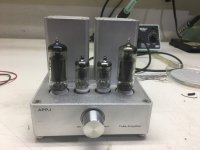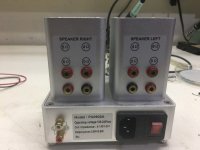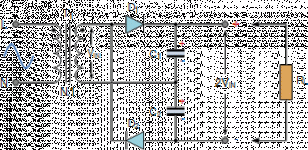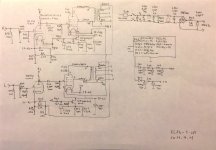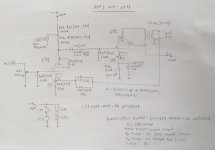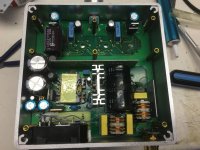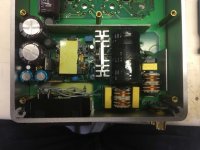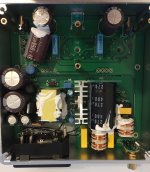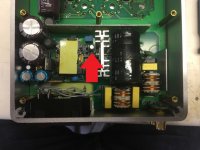Hi all.
First post after lurking for years... My office PC mini tube just died. It had been on almost continuously for a few years, but recently, due to these uncertain times, I turned it off and on a few times when leaving my office as I did not know when I could come back. When I came back to the office yesterday, I turned it on but only the power switch light came on, the tube remained cold and nothing of course came out of it.
It is a fairly rare version (APPJ PA0902A) with two 6J1 input tubes and two 6P1 power tubes. It always ran hot, including the transformers, but sound was alright--except for a strange intermittent 'crumpling paper' noise in one channel.
The fact that the tube heaters don't come on points to a failure of the switch-mode power supply (unless I am missing something).
So here are my questions:
1. Does anybody have a schematic for this amp? If it's just the power supply, It would be a waste to throw away the amplifier part with its transformers etc.
2. Is it a well-known failure mode and the power supply can be fixed? It is not-potted, so MOSFETs etc. are accessible.
3. If it is unrepairable, does anybody need these parts?
If anybody has suggestions, they would be welcome! Cheers.
--Christian
First post after lurking for years... My office PC mini tube just died. It had been on almost continuously for a few years, but recently, due to these uncertain times, I turned it off and on a few times when leaving my office as I did not know when I could come back. When I came back to the office yesterday, I turned it on but only the power switch light came on, the tube remained cold and nothing of course came out of it.
It is a fairly rare version (APPJ PA0902A) with two 6J1 input tubes and two 6P1 power tubes. It always ran hot, including the transformers, but sound was alright--except for a strange intermittent 'crumpling paper' noise in one channel.
The fact that the tube heaters don't come on points to a failure of the switch-mode power supply (unless I am missing something).
So here are my questions:
1. Does anybody have a schematic for this amp? If it's just the power supply, It would be a waste to throw away the amplifier part with its transformers etc.
2. Is it a well-known failure mode and the power supply can be fixed? It is not-potted, so MOSFETs etc. are accessible.
3. If it is unrepairable, does anybody need these parts?
If anybody has suggestions, they would be welcome! Cheers.
--Christian
Attachments
1st, make sure you are not dealing with a failed fuse.
If a fuse is not the problem, the unit's appearance and labeling lead me to think a switching PSU has failed. I see what certainly look like a pair of O/P transformers, but the provided photos reveal no sign of a power transformer.
A photographic look inside might provide some more clues.
If a switching PSU has failed, there's nothing stopping you from building a linear replacement in a secondary chassis. That can be economically done by "full wave" voltage doubling the O/P of a Triad N-68X isolation transformer.
If a fuse is not the problem, the unit's appearance and labeling lead me to think a switching PSU has failed. I see what certainly look like a pair of O/P transformers, but the provided photos reveal no sign of a power transformer.
A photographic look inside might provide some more clues.
If a switching PSU has failed, there's nothing stopping you from building a linear replacement in a secondary chassis. That can be economically done by "full wave" voltage doubling the O/P of a Triad N-68X isolation transformer.
Attachments
It's sibling amp the 0901 is known to have issues with its PSU for the heaters.
You may want to check out the images on this thread to see if the two amps use the same PSU part with the same suspect capasitors.
Let us know what you find.
https://www.diyaudio.com/forums/tubes-valves/250974-miniwatt-n3-2.html#post5157464
You may want to check out the images on this thread to see if the two amps use the same PSU part with the same suspect capasitors.
Let us know what you find.
https://www.diyaudio.com/forums/tubes-valves/250974-miniwatt-n3-2.html#post5157464
I have both the Appj 2003mini amplifier (6J1 6P1) and the PA0901A amplifier. Your PA0902A should have a 2003mini amplifier board mounted inside the PA0901A chassis. The power supply board is the same. The TOP250YN switch mode regulator has probably failed. This is a fairly inexpensive part you may source from major distributors such as Mouser. I suggest to order a spare one, because the circuit does have minimal mains surges protection and the regulator is forced at design limits edges. On my amplifier I have done a few modifications, you may check them on the thread listed above.
Attachments
I realize that on my previous post I've taken for granted the first troubleshooting step. I apologize in advance for this very basic hint, but I don't know your skills on tube technology. Have you already checked that tubes have no internal shorts? Remove all the tubes from their sockets and carefully measure the 260V DC anode voltage at output tube pins (between 6 and 3). Both filament and anode supply voltages come from the same switch mode power supply; a short in either of them will trip the output short circuit protection.
Hi all.
Thanks for the replies. Indeed, I have not tested the tubes themselves for a short. I will do that for sure. Heater power supply failure still seems a possibility. In the photos below one sees the inside. No evidence of catastrophic failure. There are voltages present on tube pins, so power supply is not completely dead. Now that I have schematics to work with, I will troubleshoot some more! Thanks again.
--Christian
Thanks for the replies. Indeed, I have not tested the tubes themselves for a short. I will do that for sure. Heater power supply failure still seems a possibility. In the photos below one sees the inside. No evidence of catastrophic failure. There are voltages present on tube pins, so power supply is not completely dead. Now that I have schematics to work with, I will troubleshoot some more! Thanks again.
--Christian
Attachments
Your APPJ 6 jpg picture it looks like you have a small cap right side or middle to right top that looks to have a bulge in the top of the cap. Could be a bad cap?
You mean the one next to the blue film cap? I think it's ok, just a photo artifact! Thanks though.
--C.
The regulator may be there to set the output tube bias; this circuit would be similar to the early appj 0901 (see attached picture). It appears that the circuit has been reverted to a cathode resistor on late 0901 amplifier production. The power supply heatsink is at mains potential. A insulation transformer is useful while servicing.
Attachments
Looked like the top of the cap was starting to dome up.
Good eye! Thanks. I looked closely and it is indeed bulging. Cheap parts? Result of something else failing? The whole thing ceased to work instantaneously. As in, I turned it off one day after using it and it didn't turn back on 3 days later...
I wonder if it's worth replacing anything...
--C.
The bulging capacitor should be C35 or C36. It has been omitted on my amplifier. It probably failed due to excess temperature. While you are replacing it, I suggest to also replace the small electrolytic capacitor next to the power supply controller chip (see picture). This is a routine replacement I do while servicing SMPS boards. That kind of capacitor on the primary side of the SMPS transformer may be on the control loop circuit or on the chip power supply; both are critical functions. The capacitor is almost always "roasted" by the power semiconductor heat. A failed or degraded capacitor results in hiccup mode operation (the SMPS turns on for a fraction of a second, then off, then on again, and so forth) or it will disable the startup completely. A high temperature, low ESR part is required. With any luck this replacement will solve the issue. If it does not, you will need to do further tests. By the way, the output tubes on your amplifier looks tired (discoloured getter).
Attachments
A high temperature, low ESR part is required.
Yes sir! Nothing less than a 105o C. rated part should be used. Panasonic and Nichicon are go to brands, for top quality, industrial grade, 'lytics.
What is the value of the parts in question, pcan? Once the value is known, Mouser's web site can be searched for suitable possibilities.
- Status
- This old topic is closed. If you want to reopen this topic, contact a moderator using the "Report Post" button.
- Home
- Amplifiers
- Tubes / Valves
- Dead mini tube amp APPJ PA0902A
